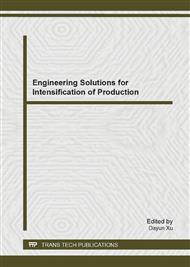[1]
J. T. Jose. Components of Successful Total Quality Management. The TQM Magazine. 17, 2 (2005) 182 – 194.
DOI: 10.1108/09544780510583245
Google Scholar
[2]
R. Anderson, H. Eriksson & H. Torstensson. Similarities and differences between TQM, six sigma and lean. The TQM Magazine, 18, 3(2006) 282-96.
DOI: 10.1108/09544780610660004
Google Scholar
[3]
C. Ax & T. Bjornenak. Management Accounting Innovations: Origins and Diffusion, in Hopper, T., Northcott, D. and Scapens, R.W. (Eds), Issues in Management Accounting, 3rd ed., Pearson, London, (2007) 357-376.
Google Scholar
[4]
R. L, Daft. New era of Management, 10th Edition. Cengage South-Western. (2011).
Google Scholar
[5]
D. W. Vorhies & N. A Morgan. Benchmarking Marketing Capabilities for Sustainable Competitive Advantage. Journal of Marketing, 69, 1(2005) 80-94.
DOI: 10.1509/jmkg.69.1.80.55505
Google Scholar
[6]
T. Stapenhurst. The benchmarking book: a how-to-guide to best practice for managers and practitioners. Oxford: Butterworth-Heinemann. (2009).
Google Scholar
[7]
G.P. Ranky. Sustainable Energy Management and Quality Process Models Based on ISO 50001: The International Energy Management Standard, NJ Institute of Technology. (2011).
DOI: 10.1109/issst.2012.6227995
Google Scholar
[8]
A.N. Salleh, S. Kasolang. & A.H. Jaafar, Review study of developing an integrated TQM with LM framework model in Malaysian automotive industry. The TQM Journal, 24, 5 (2012) 399 – 417.
DOI: 10.1108/17542731211261566
Google Scholar
[9]
B. C. Fotopoulos & L.E. Psomas, The Impact of soft" and "hard, TQM Elements on Quality Management Results. International Journal of Quality & Reliability Management. 26, 2(2009) 150-163.
DOI: 10.1108/02656710910928798
Google Scholar
[10]
S. Modell, Bundling Management Control Innovations: A Field Study of Organizational Experimenting with Total Quality Management and the Balanced Scorecard. Accounting, Auditing & Accountability Journal, 22, 1 (2009) 59-90.
DOI: 10.1108/09513570910923015
Google Scholar
[11]
E. Abrahamson, Managerial Fads and Fashions: the Diffusion and Rejection of Innovations, Academy of Management Review, 16, 3(1991) 586-612.
DOI: 10.5465/amr.1991.4279484
Google Scholar
[12]
B. Stensaker, B, Quality as fashion – Exploring the Translation of a Management Idea into Higher Education, paper presented at the seminar Dynamics and Effects of Quality Assurance in Higher Education – Various Perspectives of Quality and Performance at Various Levels, Douro, October. (2005).
DOI: 10.1007/978-1-4020-6012-0_4
Google Scholar
[13]
H. Giroux, It was such a handy term': Management Fashions and Pragmatic Ambiguity, Journal of Management Studies, 43, 6(2006) 1227-60.
DOI: 10.1111/j.1467-6486.2006.00623.x
Google Scholar
[14]
L.D. Parker, & P. Ritson, Fads, Stereotypes and Management Gurus: Fayol and Follett Today, Management Decision, 43, 10(2005) 1335-57.
DOI: 10.1108/00251740510634903
Google Scholar
[15]
W.E. Deming, Out of the Crisis, MIT Press, Cambridge, MA. (1986).
Google Scholar
[16]
R.H. Chenhall, Accounting for the Horizontal Organization: A Review Essay, Accounting, Organizations and Society, 33, 4 (2008), 517-50.
DOI: 10.1016/j.aos.2007.07.004
Google Scholar
[17]
M. Talha, Total Quality Management (TQM): An Overview, The Bottom Line: Managing Library Finances, 17, 1(2004) 15-19.
DOI: 10.1108/08880450410519656
Google Scholar
[18]
H. Sun, S. Li, K. Ho, F. Gersten, P. Hansen, & J. Frick. The Trajectory of Implementing ISO 9000 Standards versus Total Quality Management in Western Europe, International Journal of Quality & Reliability Management, 21, 2(2004) 131-53.
DOI: 10.1108/02656710410516952
Google Scholar
[19]
F. Vouzas & A. G. Psyhogios, Assessing Managers' Awareness of TQM", the TQM Magazine, 19, 1(2007) 62-75.
DOI: 10.1108/09544780710720844
Google Scholar
[20]
S. Rahman & A.S. Sohal, A Review and Classification of Total Quality Management Research in Australia and an Agenda for Future Research, International Journal of Quality & Reliability Management, 19, 1 (2002) 46-66.
DOI: 10.1108/02656710210413444
Google Scholar
[21]
R. Williams, T. Van der Wiele, J. Iwaarden & R. Viser, TQM: why it will again become a Top Management Issue", International Journal of Quality & Reliability Management, 21, 6 (2004) 603-11.
DOI: 10.1108/02656710410542025
Google Scholar
[22]
S.M. Ahmed, R.T. Aoieong, S.L. Tang & D.X.M. Zheng, A Comparison of Quality Management Systems in the Construction Industries of Hong Kong and the USA, International Journal of Quality & Reliability Management, 22, 2 (2005) 149-61.
DOI: 10.1108/02656710510577215
Google Scholar
[23]
Z. Zhang, A. Waszink & J. Wijngaard, An Instrument for Measuring TQM Implementation for Chinese Manufacturing Companies. International Journal of Quality & Reliability Management, 17, 7 (2000) 730 – 755.
DOI: 10.1108/02656710010315247
Google Scholar
[24]
H, Cartin & J. Thomas. Principles & Practices of TQM. New York, USA: ASQC Quality Press . (2009).
Google Scholar
[25]
B. S. Knouse, P.P. Carson, D.K. Carson & B.R. Heady, Improve Constantly and Forever: The Influence of W. Edwards Deming into the Twenty-First Century (2009) (449-461).
DOI: 10.1108/17542730910983371
Google Scholar
[26]
S. Karapetrovic, M. Casadesús Fa, & H.I. Saizarbitoria, H. I. What happened to the ISO 9000 Lustre? An Eight-Year Study, Total Quality Management & Business Excellence, 21, 3 (2010) 245-267.
DOI: 10.1080/14783360903553149
Google Scholar
[27]
J. Minjoon, C. Shaohan, & S. Hojung, TQM practice in Maquiladora: Antecedents of Employee Satisfaction and Loyalty. Journal of Operations Management, 13 (2006), 791-812.
DOI: 10.1016/j.jom.2005.09.006
Google Scholar
[28]
Y. Mehralizadeh, & M. Safaeemoghaddam, The Applicability of Quality Management Systems and Models to Higher Education A New Perspective. The TQM Journal. 22, 2 (2010) 175-187.
DOI: 10.1108/17542731011024282
Google Scholar
[29]
S.K.M. Ho, Integrated Lean TQM Model for Global Sustainability and Competitiveness. The TQM Journal, 22, 2 (2010) 143-58.
DOI: 10.1108/17542731011024264
Google Scholar
[30]
N.S. Dedhia, Six Sigma Basics. Total Quality Management, 16, 5 (2005) 567-574.
DOI: 10.1080/14783360500077468
Google Scholar
[31]
B.K. Ooi, N. Abubakar, V. Arumugam, L. Vellapan & A.K. Loke. Does TQM Influence Employees' Job Satisfaction? An Empirical Case Analysis. International Journal of Quality & Reliability Management, 24, 1, 1(2007) 62 – 77.
DOI: 10.1108/02656710710720330
Google Scholar
[32]
K.S. Bhat, & J. Rajashekhar, An empirical study of barriers to TQM implementation in Indian industries. The TQM Journal, 21, 3(2009) 261-72.
DOI: 10.1108/17542730910953031
Google Scholar
[33]
S. Ramasamy, Total Quality Management, Tata McGraw Hill. (2005).
Google Scholar
[34]
H.K. Jamshed, Impact of Total Quality Management on Productivity. The TQM Magazine, 15, 6 (2003) 74 – 38.
Google Scholar
[35]
M. Rouse, Just-in-Time Manufacturing (JIT Manufacturing). Retrieved 21/11/2012 from http: /what is. techtarget. com/definition/just-in-time-manufacturing-JIT-manufacturing. (2011).
DOI: 10.1007/springerreference_5694
Google Scholar


